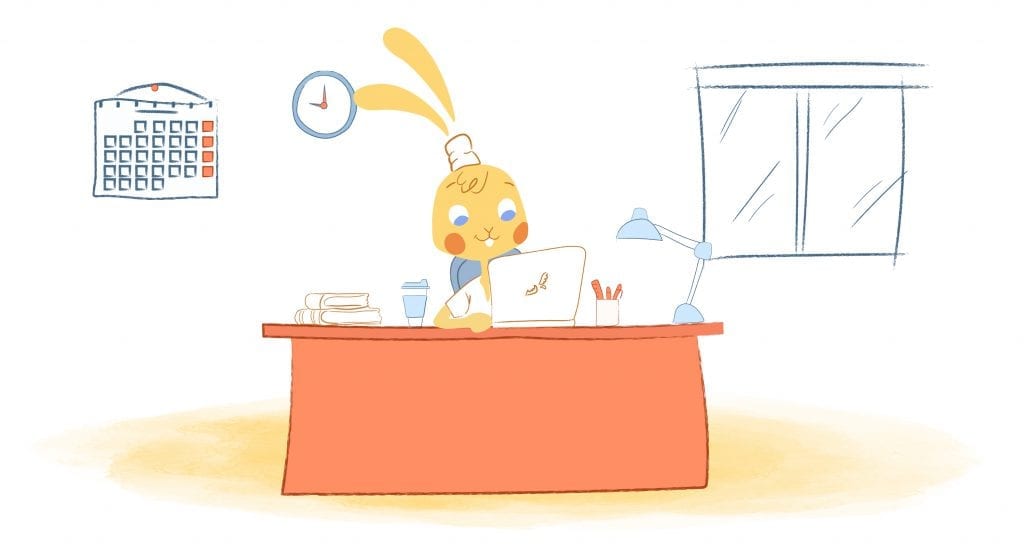

According to a study conducted by Switzerland-based serviced office provider IWG, 70 percent of professionals work remotely at least one day a week. Fifty-three percent of laborers work at least half of the week remotely. A Gallup Poll found that the number of American employees working remotely increased 43 percent in 2016, from 39 percent in 2012. Here is a guide to setting up your perfect home office.
How Technology is Makes Remote Work Possible.
New technology is making working from home, or some other convenient location, increasingly possible. Many more companies are warming up to the idea of hiring remote workers in their industries. Technology advances show an expectation that these figures will continue to rise.
Setting up your home office.
Yes, there are some guidelines for setting up your home office. Working remotely every-once-in-a-while, once a week or full-time deserves a great home office space. You can use this handy guide to make sure that your home office is designed to make you as productive as possible.
Choose a Dedicated Area for Your Home Office
The first step you need to take when setting up your home office is actually to find an area where you’ll want to work. Ideally, this space should be a separate room located in a quiet section of your home. Having a room with a door is suggested since it can provide you with privacy.
Spring for the right door.
A great door is especially crucial if you live with your family or roommates. For example, a spare bedroom would be an excellent option for your home office. If you don’t have an extra bedroom, consider a basement or garage that can be converted into an office space. If space is minimal, you may have to settle for somewhere like the kitchen or dining area.
Ever hide in the closet? Still works today.
You may even want to get creative and convert an unused closet or corner of your living room into a small office. Thanks to space-saving floating shelves and other amenities you’ll be set up in no time. Think Home Depot, IKEA, and online shopping ideas for purchases. Instagram has some great ideas that don’t cost a fortune.
If you have the land, you can purchase a tiny home and use that as your office so that you’re not working inside your home. A new coat of paint on the shed in your backyard works excellent. Make this shed, or space, incredible, and just for you; you’ll be spending a lot of time here.
Quick entry for clients.
One final note, if you plan on meeting with clients in your home office, then try to have your office as close to the entrance as possible. Easily accessible entry to your office will prevent people from walking through your other rooms. But you want to appear every bit the professional you are becoming.
Invest in the Right Tools and Equipment
Now, you’ve found the greatest place to work in your home. Next, you’ll want to create a list of all the office tools and equipment you will want. Your equipment may vary from job to job. For example, if you’re a graphic artist, then you’re going to need a computer desk and a larger desk or table for your artwork. In this case, you’ll need to invest in specialized equipment, tools, or software.
Here are the essential tools and equipment every home office should hold:
- High-speed internet access to eliminate frustration and keep you productive.
- Network router that can handle all of your Wi-Fi demand.
- Own a computer that has enough power and memory to suit your needs.
- Telephone or VoIP so that you have reliable communication.
- Printer/scanner/fax — even though we live in a paperless world, there will be times you need to print out relevant documents like contracts.
- Have a surge protector to protect your electronic devices during power surges.
- Uninterruptible Power Supply (UPS) so that you can keep working when the power goes out.
What does your desk space look like?
- Desk — have a large enough area for you to work.
- Ergonomics — such as a good chair, mouse, and an additional monitor. Include a footrest to keep you comfortable.
- Headphones — have a microphone, and have the headphones that block out noise and encourages hand free communication.
- Software — Google Drive, Skype, Slack, or Calendar to communicate and collaborate.
- Filing cabinet — storage and organize essential documents — and a drawer to quickly ditch a mess.
Though useful — allow your items to create comfort.
- Whiteboard for your to-do-lists, goals, and ideas. It’s also a great way to stand-out occasionally.
- Mini-fridge filled with healthy snacks, as well as water and coffee so that you don’t have to visit the kitchen.
- Plants boost productivity. Stick with plants that can survive in low-light and an office environment. These include bonsai plants, the Neon Pothos, Snake Plant, and the Red-Edged Dracaena — these can take your neglect.
Brighten Your Office With Lighting and Color
Your home office should have a window. Natural light improves your productivity by maintaining circadian rhythm. Daylight also makes people feel more energized and cheerful. Even most sheds have a window.
If your office doesn’t have access to direct sunlight, then you’ll want to purchase overhead lights that fill most of the work area. Have a good quality desk lamp, floors lamp, and task-lighting lamp for concentrated lighting. There are even daylight-replicating light sources that are energy-efficient, while still providing you with full-spectrum lighting.
Keep aesthetics in mind — as well as the lighting.
Just keep in mind that regardless of the type of lightning in your home office, make are sure your computer screen is positioned in a way that prevents glare. Some computer glasses also help prevent eye strain from occurring.
On top of the lighting, paint your office in a color that matches your job. For example:
- Blue is an intellectual color, making it perfect for jobs that require focus.
- Red is a vibrant and physical color. Use this color if your job demands physical exertion.
- Yellow is an emotional color. It’s ideal for stimulating positivity and creativity.
- Green provides balance and is easy on the eyes. If you spend a lot of time in your home office, then this is your go-to-color.
- Purple is often associated with spirituality or luxury but should be used sparingly and carefully.
- Orange can create a sense of comfort but is often used in kitchens or casual lounges.
- Gray represents neutrality and is used in the modern office. It can stimulate a depressing mood when misused. Gray can reveal a quiet and contemplative space.
Personalize Your Home Office
It’s your office, so go ahead and add some personalization. Incorporating personal items like photos, your own coffee mug or knick-knacks will make your space a piece of you. Maybe you could include a gift or memento from someone special or a little desk rake and sand to help you think. Add anything that will help you make this office or workspace shouts, “This is where I work!”
Inspiring, uplifting quotes.
Have a list of your favorite quotes nearby that make you feel happier and more inspired. Inspiring thoughts and quotes help you work more efficiently, and these sayings will give you a sense of ownership.
Absolutely anything that is done in excess — is too much.
Just make sure that you don’t overdo it. Remember, it’s still your office and not your den.
Create Work Zones in Your Home
Creating “work zones” in your home is an idea that people use when planning their kitchens. As described in an article for Divine Design + Build, the work zone is where “you group things based on their specific function.” For example, your kitchen will have a “cooking zone” where all of your appliances are located. Then all the equipment to cook is in the same spot of the kitchen — together. Everything you will need to cook is within arm’s reach for specific tasks.
The same idea can be applied to your home office. For instance, you could create one zone called the “work center.” This is where your desk, computer, or whatever else you use daily are located.
Another work zone could be the “supply” zone where you store all of your paper, pens, or business cards or a reference library where industry books and publications will be found.
Keep Your Office Clean and Organized
If you’ve created zones before, then organizing your home office shouldn’t be an issue. After all, this helps you follow the rule “a place for everything and everything in its place.” But, this doesn’t work when the items that you’ve used aren’t returned to their homes. As a general rule, whenever you’re finished using an item, put it back where it belongs — so that you know it’s there the next time you need it.
You don’t want your home office to become so cluttered that it becomes difficult to focus. When there’s a mess, our minds tend to focus on the junk instead of the task at hand. At the end of the day, do a quick clean, like putting any files in the proper folder in the cabinet. A small cleanup daily, not only keeps your home office organized, but you also won’t spend too much time cleaning it.
Separate the Professional from the Personal
Keeping things separate may not seem like a big deal, but to avoid any confusion, it’s essential that you keep your personal and professional lives separate. You will want to have a list that includes having separate phone lines, computer, and bank accounts, as well as segmenting tax documents. For example, all of your tax deductions for your business should be stored in your home office.
Establish Work Hours
The beauty of working from home is that you can set a more flexible schedule that’s based around when you’re most productive or lifestyle. For example, your work hours could be between eight am and three pm while you’re kids are in school.
Please do not disturb.
When you set your office hours, be strict about them. Let’s say the kids get home early because they had a half-day. Make it known to them that you’re still working until three pm. Sharing a family calendar, keeping your door closed, or placing a ‘Do Not Disturb’ sign prevent others from disrupting you.
Furthermore, when setting your schedule, make sure that you arrive on time, take frequent breaks, and quit at a reasonable hour. It’s an effective way to keep you motivated and productive when working from home.
Be Aware of Distractions at Home
Working from home comes with a variety of unique distractions, such as your kids and family members, emails, phone, background noises, and household chores.
You need to not only be aware of these distractions, but you also have to find ways to avoid them by:
- Get your family on-board. Explain to them that just because you work from home doesn’t mean that you can take your career lightly. Establish boundaries so your family can give you the space you need to work.
- Don’t check your email or phone every time you receive a notification. Check them at specific times throughout the day. You should go ahead and turn-off these notifications while working. You could also keep your phone in another part of the house.
- Set a schedule and stick to that schedule.
Is your workspace quiet enough? Too quiet?
- When there’s too much noise, either listen to music or sounds found on an app like Nosli. You could also just put-on noise-canceling headphones.
- Only work in your home office so that you’re not tempted to watch TV in the living room. Working in one place is also part of the keeping business and personal lives separate.
- Set aside once a week for significant household chores. If you’re too overwhelmed, delegate certain duties to your family or hire someone to come in and clean for you.
Learn to Manage Your Time from your Home Office
Everyone struggles with time management. But, this new home office can be particularly difficult for the person who has just started working from home. There aren’t exact start and stop times or managers and colleagues to keep you on track.
Sticking to a schedule that is based on your natural workflow and your life, eliminating distractions, and working in your home office are all great places to start.
Additionally, give the following time management tricks a try:
- Spend your mornings working on your most important and challenging tasks. Morning is usually when you’ll have the most focus, and this habit will give you momentum for the rest of the day.
- Follow the rule of 52 and 17. This rule means working straight for 52 minutes and taking a 17-minute break to give your brain a chance to rest and recharge. Spend your break going for a walk, reading, or meditating.
- Use a timer. For example, when it’s time to check your emails, set a timer for 15-minutes. Regardless if your inbox is at zero, once the timer goes off, you move on to another task.
- Don’t waste time. Let’s say you have a dentist appointment, instead of wasting time sitting in the waiting room, spend that time productively by checking your email, updating your to-do-list, or syncing your files so that you can keep up on your work schedule.
Let me share your calendar:
- Batch similar tasks together. This way you’re not shifting focus from task-to-task. Also, this prevents you from always pulling things out and putting them back. For example, you could do all of your meal prep on Sundays so that you don’t have to cook or clean during the week.
- Create theme days. Schedule all of your meetings on the same day so that you aren’t interrupting your workflow. You should also specific days for brainstorming or handling household chores like laundry and cleaning.
- Find inspiration for when you’re not motivated. Working from home can get lonely. There are also days when you need some inspiration. When you’re feeling this way, watch a Ted Talk, read an inspiring biography, find a mentor, or connect with other remote workers online or at local networking events. You may even want to get off the home office occasionally. Consider working at a coffee shop or co-working space.











Abby Miller
Student at UC Berkeley, currently working on a degree in Electrical Engineering/Computer Sciences and Business Administration. Experienced in CSX, productivity management, and chatbot implementation.